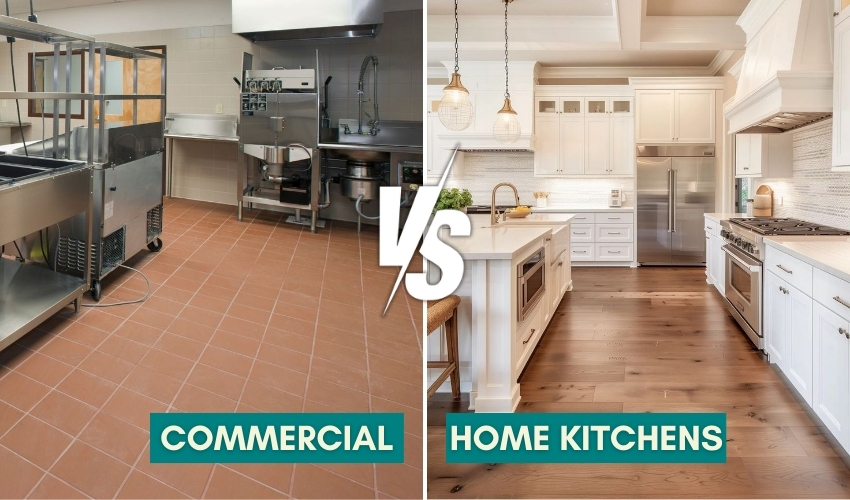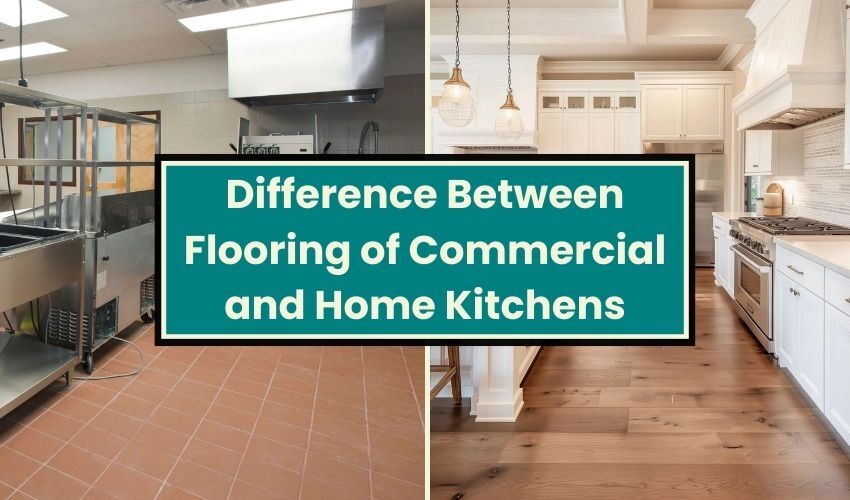The thing that makes a kitchen one-of-a-kind is its flooring rather than its appliances and walls. The reason is simple: the floors are the first thing you will notice. This aesthetic feature is usually for the home kitchen, but for commercial kitchens, the criteria differ. The reasons for these are the difference in level of usage, the safety requirements, and the hygiene standards. Our post for today is all about finding the differences between the flooring of commercial and home kitchens.
8 Critical Differences Between Commercial & Home Kitchen Flooring

1. Durability and Usage
Commercial Kitchen:
These kitchens are the hub of activity, with chefs and waiter staff with equipment constantly in motion. The flooring in Dubai must withstand the heavy foot traffic, the impact of the moving heavy equipment, and often the falling weight of utensils and pots. For these commercial kitchen floors, the most optimal choices are quarry tiles, concrete floors, or ones with epoxy resins. All these offer a high wear & tear resistance and last much longer.
Home Kitchen:
In contrast to this, a home kitchen provides moderate foot traffic usage, but still durability is a high factor to consider. This flooring does not have to suffer the same level of strain as the commercial floors. The popular choices for the home kitchen floors include laminate, LVT, and ceramic tiles. They offer the right compromise of beauty and durability.
2. Hygiene and Cleanliness
Commercial Kitchen:
Cleanliness is the key to any good commercial kitchen, in fact, it’s a priority. As such, the floor must also meet the strict health and safety regulations. This means you should buy a non-porous option from a flooring company, which is easy to clean and resistant to most stains. Floors in the commercial kitchen also have protective finishes to prevent the bacteria and food particles from trapping within the crevices and cracks. This is the reason most commercial kitchens have welded vinyl sheet or epoxy flooring.
Home Kitchen:
Hygiene is certainly important for home kitchens but the standard is not as strict as compared to commercial ones. Homeowners mostly opt for flooring which is easy to clean and requires less maintenance. They also love to choose floors with visible grout lines or seams like wooden planks or tiles.
3. Safety Features
Commercial Kitchen:
Safety is also a concern in the commercial kitchen, where there is always the risk of slipping and falling over due to wet surfaces. Flooring must offer robust slip resistance for which safety mats, textured surfaces, and anti-slip coatings are used. They must also meet the safety standards like the ones set by the Occupational Safety and Health Administration (OSHA).
Home Kitchen:
Like commercial ones, these kitchens, too, require a safety element, particularly for homes with the elderly and children. However, the focus is to use flooring that doesn’t compromise the beauty effect. These floors are treated with anti-slip finishes for safety, or area rugs & mats are placed for added foot traction.
4. Design and Aesthetics
Commercial Kitchen:
For commerce spaces, functionality always takes one up on aesthetics. There are some high-end restaurants that offer visually appealing flooring for their setup of open kitchens, but most of them focus on practicality & performance over beauty & styles. These floors are even opted in neutral colors for hiding away the look of stains and matte finishes for easy cleaning and foot traction.
Home Kitchen:
The design aesthetics are the most important for the home kitchen. Homeowners need materials that offer the best décor to create an inviting atmosphere. The most popular options for residential kitchens are mostly patterned tiles with natural wood finishes and vibrant colors. These tiles are often available in customized options to get the desired look and feel for homeowners’ aesthetic tastes.
5. Maintenance and Cleaning
Commercial Kitchen:
This flooring is made to offer easy cleaning and maintenance to meet the standards of health codes. Most often, commercial places use pressure washers, steam cleaners, and industrial-grade floor cleaners to clean these surfaces. The material for these floors must withstand the tough cleaning processes without losing their integrity.
Home Kitchen:
Maintenance for the kitchen floors in homes is a bit less demanding. One can do it with simple sweeping and mopping but with the need for occasional deep cleaning. All this helps keep home kitchen floors in pristine condition. The best choices for these are the vinyl and laminate – all of them are low maintenance. In case one decides on stone or ceramic tiles, they must do proper sealing to prevent any stains.
6. Cost Implications
Commercial Kitchen:
Commercial kitchen floors are a significant investment because they are designed for long-term use, prioritizing durability and safety features. The materials used must be high-performance, and they require professional flooring installation service, which is quite expensive. Still, thinking long-term, these floors require fewer repairs or replacements, which is cost-effective on its own.
Home Kitchen:
For residential kitchens, the budget can be quite flexible, and one can choose from a wide range of materials. There are affordable vinyl floors and luxury stone or wooden floorings. There are also options like the click-lock tiles that allow one to DIY install these floors, lowering your overall costs.
7. Temperature and Moisture Resistance
Commercial Kitchen:
These floors must withstand high temperatures, such as exposure to steam, moisture, and hot liquid spills. Quarry tiles or epoxy resin flooring offer the best resistance to these elements, making them ideal for such intense cooking environments.
Home Kitchen:
Moisture resistance is key to the longevity of these flooring in homes. The exposure to extreme conditions is limited, but it happens occasionally. This is why the best choice for these floorings is vinyl or sealed wood, which offers protection against humidity and spills.
8. Noise Reduction
Commercial Kitchen:
Noise control is not the main concern for commercial kitchens; instead, the focus is on functionality. Flooring is typically made of tiles or concrete, both of which can generate a lot of noise underfoot. However, this is generally not a major concern, as the constant flow of orders and high foot traffic make the noise less noticeable.
Home Kitchen:
For home kitchens, there is a need for noise reduction, especially if it’s an open-plan kitchen design. There are options like cork or rubber. Then there are the padded vinyl option or noise-absorbing backing layers for wooden floors. All these help dampen the noise from feet to create a serene cooking environment.
Conclusion
When you choose kitchen flooring, you need to identify the needs of the space, such as the commercial and residential ones. The differences between commercial and home kitchen floors guide owners in choosing the right type.
For a commercial kitchen, keep an eye on the non-slip, durable, and easy-to-clean flooring options. For the kitchen at home, the floors must be aesthetic, comfortable, and moderately durable. Whether you are creating a cozy cooking space at home or designing a busy restaurant kitchen, the right flooring makes all the difference in style & functionality.




